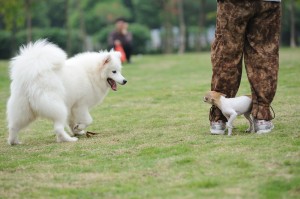 Have you been longing to take your dog to a dog park? Perhaps you just adopted a dog and are debating whether this experience would be good for him.
Have you been longing to take your dog to a dog park? Perhaps you just adopted a dog and are debating whether this experience would be good for him.
Below are some tips to help you decide if the dog park is right for your pet as well as a few tips to make your visit safe and enjoyable.
Will this be good for my dog?
If your dog has experience playing off leash with another dog, that is a wonderful canine experience. But playing with one or even two, verses playing with the masses is not equivalent. Before going to a dog park, it is beneficial to test the dog’s response to a pack environment in a controlled, monitored environment such as a dog daycare facility. These facilities are staffed with professionals who are experienced in dog play and canine body language. They can tell you if your dog is happy and soliciting new friends, or if the pack makes him uneasy, resulting in Fido not wanting to play. Some dogs may become frightened or agitated within a large group of their furry peers, resulting in a not so pleasant experience.
Not all dogs are candidates for a dog park.
We have a dog in our pack that loves to socialize and the more dogs the better. We have another who becomes overwhelmed when confronted by a pack. There is nothing wrong with either dog. Knowing your dog’s play preference and pack tolerance can help you make good decisions for your pet.
Good for socialization?
A dog park can be a wonderful place for a fully socialized dog to play with others. It is not the place to begin socialization or to test if a recently acquired dog has been adequately socialized. There is a world of difference between the two. Socialized dogs have already proven themselves comfortable with the world around them and show no fear or aggression in the presence of strangers, crowds or large groups of off-leash dogs. Equally important, these dogs have already learned through experience how to play with other dogs and respond appropriately to other dog’s signals and body language. If your dog has not been through a formal socialization program or if you are unsure how your dog feels about being in a pack of dogs, please do not bring him to the park just yet. Scheduling private play dates or participating in a doggie day care group will provide the answers you seek in an environment that is safe and non-threatening for your dog. Putting an unsocialized dog into a dog park can be damaging. Most dogs will not tolerate rude play behavior created by inexperience. For the novice dog, this lack of understanding can result in escalating levels of corrections from the pack. Unsocialized dogs are likely to fail in a pack environment and become overwhelmed resulting in fearful or aggressive behavior.
Toy and Treats
Presenting toys or treats to your dog at the park will create a competitive environment. To keep peace among the pack, it is best to leave those items at home.
Monitoring your dog
Watch your dog at all times so that you know what he is doing and with whom he is playing. A dog’s behavior can change in an instant and it only takes the entrance of one dog with a different energy to turn an otherwise peaceful pack into a frenzied one.
Leashing
In a pack environment where dogs are running free, having yours on leash puts him at a disadvantage and may make him a target. A dog’s leash should be removed as soon as the gate closes behind you and shouldn’t be reapplied until you are back at the gate, ready to leave.
If you are thinking to yourself, there is no way, I have to keep the leash on for control, your dog probably is not ready for the park.
Dogs have two ways to deal with stress…fight or flight. Restraining a dog with the leash removes flight as an option. Even if the dog loves the park and knows everyone there, he has to be able to move away at his discretion.
Four on the floor
It may be tempting to pick your dog up especially if a larger dog is running toward him. Despite the best intentions to bring comfort to the dog this act will have the opposite effect if your dog is in a pack environment. A dog in arms is restrained …even if he is in your arms…arms he loves. Additionally, elevation is directly related to status in the dog world. A dog in arms is naturally held higher than the rest of the pack. The resulting action is that other dogs are likely to run over and start jumping at the restrained dog in an attempt to determine what warrants this coveted position above the rest of the pack. Your dog is much safer on the ground.
Avoiding human conflict
In a dog park, you will be in the company of dog enthusiasts, folks who may like to exchange stories and offer tips and advice. This can be great fun and makes going to the dog park a social event for humans too! Just keep in mind that dogs are often considered family members and owners may be sensitive to the comments and advice of others.
Criticizing another person’s dog or questioning an owner’s “parenting” skills is one of the fastest ways to create conflict.
If you feel obligated to speak to another individual about their pet’s behavior, please be courteous and kind. Try not to rush to judgment as things are not always as they appear to be and jumping to conclusions may create unnecessary conflict. Speaking of which, many people are opposed to direct conflict. Listen carefully to the things people say to you as these friendly strangers may be trying to tell you something about your dog’s behavior. Very few people will ask another person to remove their dog from the park until there is a fight or a bite. Often, people will make innocuous comments such as, “Wow, he’s really fired up today!” “Does he always play like that?” or “He sure doesn’t take no for an answer, does he?” People may be trying to tell you that your dog’s behavior is making them or the other dogs uncomfortable. If this is the case, you may want to take a closer look at your dog’s behavior. A person swiftly leaving the park is another signal. Pay close attention to this human behavior especially if the dog that is leaving was just playing with yours. Many people find it easier to avoid a confrontation.
Body Talk
Dogs communicate with their bodies utilizing body language. Canine body language is universal in the dog world and socialized dogs understand the language perfectly. Unfortunately, these subtle cues are often lost on humans because we speak a completely different language!
Understanding canine body language allows you to decipher what your pet is saying to you, and to the rest of the world.
And since he is communicating with other dogs at the park, it is in everyone’s best interest if you can eavesdrop on those canine conversations. Dog parks can be excellent gathering places for socialized dogs and their humans. Just remember that it is the dog owner’s responsibility to ensure that their dog is suited for this environment and is behaving appropriately while there. Learning the basics about canine body language and safe play can help you make good decisions for your pet. Not every dog is suited for an off-leash pack environment and your dog may be one of them. But if he is suited, you and your dog are in for a great time! Woof! Who’s up for a romp in the park?
The goal of all dog training is to provide peaceable solutions to everyday problems so that pets and their owners live harmoniously. Paws in Training provides dog and cat training services in Raleigh, Apex, Holly Springs, Cary, Fuquay Varina and Garner, N.C.

